Askeland D.R., Fulay P.P. Essentials of Materials Science & Engineering
Подождите немного. Документ загружается.

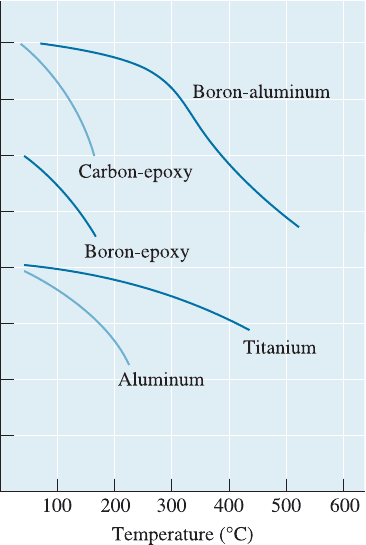
Hybrid composites are composed of two or more types of fibers. For instance,
Kevlar
TM
fibers may be mixed with carbon fibers to improve the toughness of a sti¤
composite, or Kevlar
TM
may be mixed with glass fibers to improve sti¤ness. Partic-
ularly good tailoring of the composite to meet specific applications can be achieved by
controlling the amounts and orientations of each fiber.
Tough composites can also be produced if careful attention is paid to the choice of
materials and processing techniques. Better fracture toughness in the rather brittle
composites can be obtained by using long fibers, amorphous (such as PEEK and PPS)
rather than crystalline or cross-linked matrices, thermoplastic-elastomer matrices, or
interpenetrating network polymers.
Metal-Matrix Composites These materials, strengthened by metal or ceramic fibers,
provide high-temperature resistance. Aluminum reinforced with borsic fibers has been
used extensively in aerospace applications, including struts for the space shuttle.
Copper-based alloys have been reinforced with SiC fibers, producing high-strength
propellers for ships.
Aluminum is commonly used in metal-matrix composites. Al
2
O
3
fibers reinforce
the pistons for some diesel engines; SiC fibers and whiskers are used in aerospace ap-
plications, including sti¤eners and missile fins; and carbon fibers provide reinforcement
for the aluminum antenna mast of the Hubble telescope. Polymer fibers, because of
their low melting or degradation temperatures, are not normally used in a metallic
matrix. Polymets, however, are produced by hot extruding aluminum powder and high-
melting-temperature liquid-crystalline polymers. A reduction of 1000 to 1 during the
extrusion process elongates the polymer into aligned filaments and bonds the aluminum
powder particles into a solid matrix.
Specific strength (3 10
6
cm)
0.5
1
1.5
2
2.5
3
3.5
4
0
Figure 17-26
The specific strength versus
temperature for several composites
and metals.
C HA P T E R 1 7 Composites: Teamwork and Synergy in Materials570
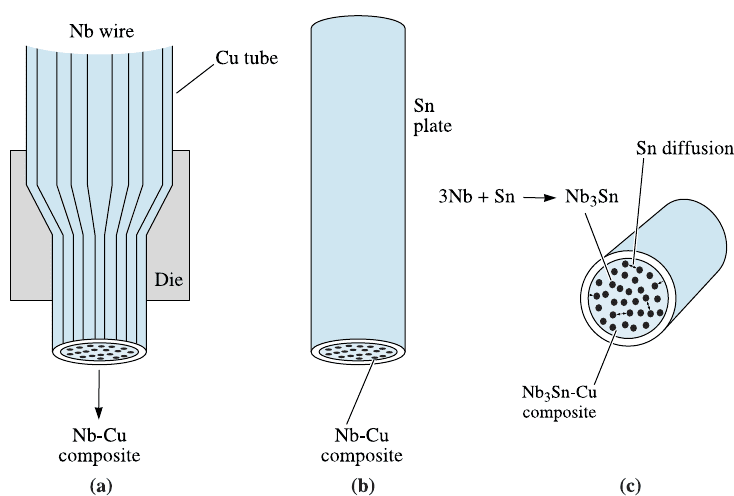
Metal-matrix composites may find important applications in components for rocket
or aircraft engines. Superalloys reinforced with metal fibers (such as tungsten) or
ceramic fibers (such as SiC or B
4
N) maintain their strength at higher temperatures,
permitting jet engines to operate more e‰ciently. Similarly, titanium and titanium alu-
minides reinforced with SiC fibers are considered for turbine blades and disks.
A unique application for metal-matrix composites is in the superconducting wire
required for fusion reactors. The intermetallic compound Nb
3
Sn has good super-
conducting properties but is very brittle. To produce Nb
3
Sn wire, pure niobium wire is
surrounded by copper as the two metals are formed into a wire composite (Figure 17-27).
The niobium-copper composite wire is then coated with tin. The tin di¤uses through the
copper and reacts with the niobium to produce the intermetallic compound. Niobium-
titanium systems are also used.
Ceramic-Matrix Com posites Composites containing ceramic fibers in a ceramic matrix
are also finding applications. Two important uses will be discussed to illustrate the
unique properties that can be obtained with these materials.
Carbon-carbon (C—C) composites are used for extraord inary temperature resist-
ance in aerospace applications. Carbon-carbon composites can operate at temperatures
of up to 3000
C and, in fact, are stronger at high temperatures than at low temperatures
(Figure 17-28). Carbon-carbon composites are made by forming a polyacrylonitrile or
carbon fiber fabric into a mold, then impregnating the fabric with an organic resin, such
as a phenolic. The part is pyrolyzed to convert the phenolic resin to carbon. The com-
posite, which is still soft and porous, is impregnated and pyrolyzed several more times,
continually increasing the density, strength, and sti¤ness. Finally, the part is coated with
silicon carbide to protect the carbon-carbon composite from oxidation. Strengths
of 2070 MPa and a Young’s modulus (measure of sti¤ness) of 345 10
3
MPa can be
Figure 17-27 The manufacture of composite superconductor wires: (a) Niobium wire is
surrounded with copper during forming. (b) Tin is plated onto Nb-Cu composite wire. (c) Tin
diffuses to niobium to produce the Nb
3
Sn-Cu composite.
17-6 Fiber-Reinforced Systems and Applications 571
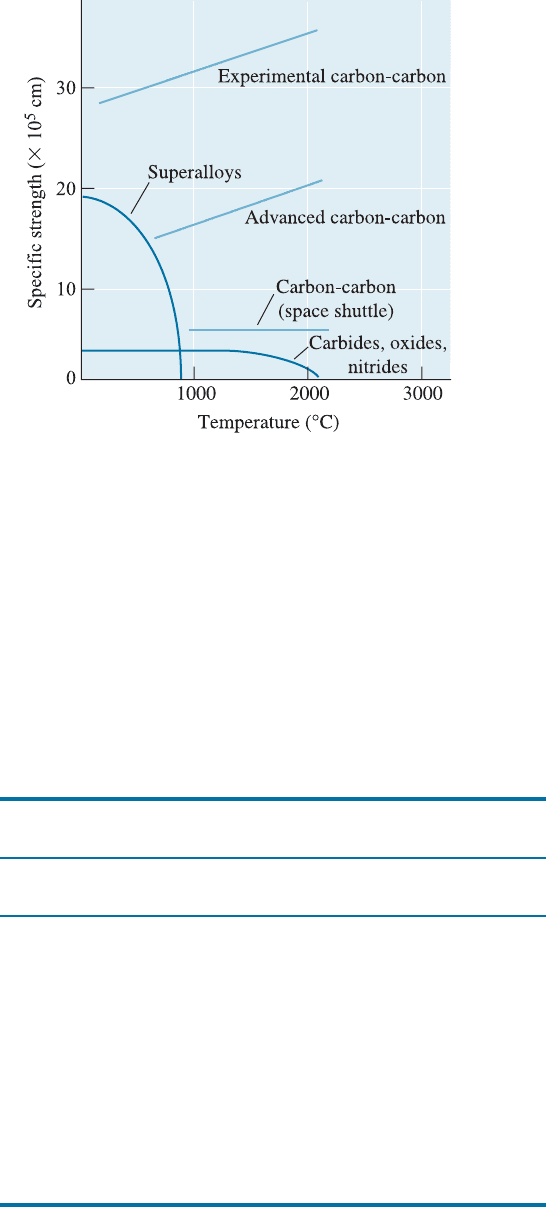
obtained. Carbon-carbon composites have been used as nose cones and leading edges
of high-performance aerospace vehicles such as the space shuttle, and as brake discs
on racing cars and commercial jet aircraft.
Ceramic-fiber–ceramic-matrix composites provide improved strength and fracture
toughness compared with conventional ceramics (Table 17-4). Fiber reinforcements
improve the toughness of the ceramic matrix in several ways. First, a crack moving
through the matrix encounters a fiber; if the bonding between the matrix and the fiber is
poor, the crack is forced to propagate around the fiber in order to continue the fracture
process. In addition, poor bonding allows the fiber to begin to pull out of the matrix
[Figure 17-29(a)]. Both processes consume energy, thereby increasing fracture tough-
ness. Finally, as a crack in the matrix begins, unbroken fibers may bridge the crack,
providing a compressive stress that helps keep the crack from opening [Figure 17-29(b)].
Figure 17-28
A comparison of the specific
strength of various carbon-carbon
composites with that of other
high-temperature materials
relative to temperature.
TABLE 17-4 9 Effect of SiC-reinforcement fibers on the properties of
selected ceramic materials
Material
Flexural Strength
(MPa)
Fracture Toughness
(MPa
ffiffiffiffi
m
p
)
Al
2
O
3
550 5.5
Al
2
O
3
/SiC 790 8.8
SiC 500 4.4
SiC/SiC 760 25.3
ZrO
2
210 5.5
ZrO
2
/SiC 450 22.2
Si
3
N
4
470 4.4
Si
3
N
4
/SiC 790 56.0
Glass 60 1.1
Glass/SiC 830 18.7
Glass ceramic 210 2.2
Glass ceramic/SiC 830 17.6
C HA P T E R 1 7 Composites: Teamwork and Synergy in Materials572
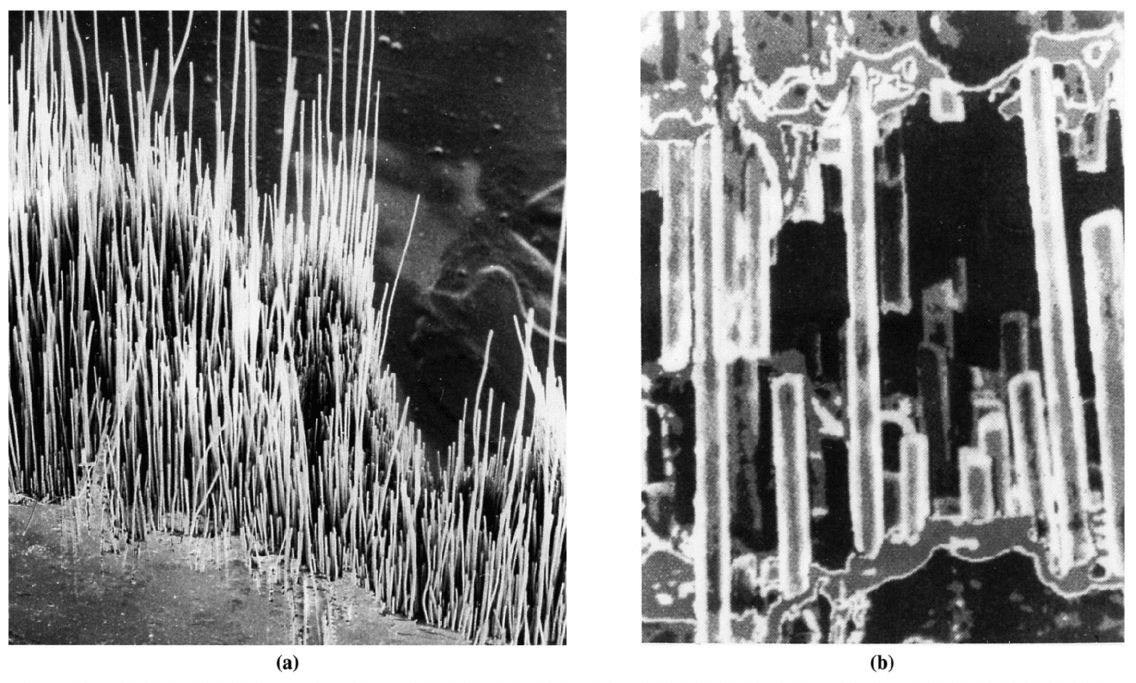
Figure 17-29 Two failure modes in ceramic-ceramic composites: (a) Extensive pull-out of SiC fibers in a glass matrix provides good composite
toughness (20). (From Metals Handbook, American Society for Metals, Vol. 9, 9th Ed., 1985.) (b) Bridging of some fibers across a crack
enhances the toughness of a ceramic-matrix composite (unknown magnification). (From Journal of Metals, May 1991.)
17-6 Fiber-Reinforced Systems and Applications 573

Unlike polymer and metal matrix composites, poor bonding—rather than good
bonding—is required! Consequently, control of the interface structure is crucial. In a
glass-ceramic (based on Al
2
O
3
SiO
2
Li
2
O) reinforced with SiC fibers, an interface
layer containing carbon and NbC is produced that makes debonding of the fiber from
the matrix easy. If, however, the composite is heated to a high temperature, the inter-
face is oxidized; the oxide occupies a large volume, exerts a clamping force on the fiber,
and prevents easy pull-out. Fracture toughness is then decreased. The following exam-
ple illustrates some of the cost and property issues that come up while working with
composites.
EXAMPLE 17-10
Design of a Composite Strut
Design a unidirectional fiber-reinforced epoxy-matrix strut having a round
cross-section. The strut is 3 m long and, when a force of 2224 N is applied, it
should stretch no more than 0.25 cm. We want to assure that the stress acting
on the strut is less than the yield strength of the epoxy matrix, 83 MPa. If the
fibers should happen to break, the strut will stretch an extra amount but may
not catastrophically fracture. Epoxy costs about $1.8/kg and has a modulus of
elasticity of 3450 MPa.
SOLUTION
Suppose that the strut were made entirely of epoxy (that is, no fibers):
e
max
¼
0:25 cm
300
¼ 0:00083 cm=cm
s
max
¼ Ee ¼ð3450Þð0:00083Þ¼2:9 MPa
A
strut
¼
F
s
¼
2224 N
2:9 MPa
¼ 7:67 cm
2
or d ¼ 3:12 cm
Since r
epoxy
¼ 1:25 g/cm
3
,
Weight
strut
¼ð1:25ÞðpÞð3:12=2Þ
2
ð300Þ¼2:87 kg
Cost
strut
¼ð2:87 kgÞð$1:8=kgÞ¼$5:17
With no reinforcement, the strut is large and heavy; the materials cost is high
due to the large amount of epoxy needed.
In a composite, the maximum strain is still 0.00083 cm/cm If we make the
strut as small as possible—that is, it operates at 83 MPa—then the minimum
modulus of elasticity E
c
of the composite is:
E
c
>
s
e
max
¼
83
0:00083
¼ 100 10
3
MPa
Let’s look at sever al possible composite systems. The modulus of glass fibers is
less than 100 10
3
MPa; therefore, glass reinforcement is not a possible choice.
For high modulus carbon fibers, E ¼ 531 10
3
MPa; the density is 1.9 g/cm
3
,
and the cost is about $66/kg. The minimum volume fraction of carbon fibers
needed to give a composite modulus of 100 10
3
MPa is:
E
c
¼ f
C
ð531 10
3
Þþð1 f
C
Þð3:45 10
3
Þ > 100 10
3
f
C
¼ 0:183
C HA P T E R 1 7 Composites: Teamwork and Synergy in Materials574

The volume fraction of epoxy remaining is 0.817. An area of 0.817 times the
total cross-sectional area of the strut must support a 2224 N load with no more
than 83 MPa if all of the fibers should fail:
A
epoxy
¼ 0:817A
total
¼
F
s
¼
2224 N
83 MPa
¼ 0:268 cm
2
A
total
¼
0:268
0:817
¼ 0:328 cm
2
or d ¼ 0:646 cm
Volume
strut
¼ A
total
¼ð0:328 cm
2
Þð300 cmÞ¼98:4cm
3
Weight
strut
¼ rV ¼½ð1:9Þð0:183Þþð1:25Þð0:817Þð98:4Þ
¼ 0:135 kg
Weight fraction carbon ¼
ð0:183Þð1:9g=cm
3
Þ
ð0:183Þð1:9Þþð0:817Þð1:25Þ
¼ 0:254
Weight carbon ¼ð0:254Þð0:135 kgÞ¼0:034 kg
Weight epoxy ¼ð0:746Þð0:135 kgÞ¼0:101 kg
Cost of each strut ¼ð0:034Þð$66Þþð0:101Þð$1:80Þ¼$2:42
The carbon-fiber reinforced strut is less than one-quarter the diameter of an all-
epoxy structure, with only 5% of the weight and half of the cost.
We might also repeat these calculations using Kevlar
TM
fibers, with a mod-
ulus of 124 10
3
MPa, a density of 1.44 g/cm
3
, and a cost of about $44/kg. By
doing so, we would find that a volume fraction of 0.8 fibers is required. Note that
0.8 volume fraction is at the maximum of fiber volume that can be incorporated
into a matrix. We would also find that the required diameter of the strut is
1.288 cm and that the strut weighs 0.573 kg and costs $20.94. The modulus of
the Kevlar
TM
is not high enough to o¤set its high cost.
Although the carbon fibers are the most expensive, they permit the lightest
weight and the lowest material cost strut. (This calculation does not, how-
ever, take into consideration the costs of manufacturing the strut.) Our design,
therefore, is to use a 0.646-cm-diameter strut containing 0.183 volume fraction
high-modulus carbon fiber.
17-7 Laminar Composite Materials
Laminar composites include very thin coatings, thicker protective surfaces, claddings,
bimetallics, laminates, and a host of other applications. In addition, the fiber-reinforced
composites produced from tapes or fabrics can be considered partly laminar. Many
laminar composites are designed to improve corrosion resistance while retaining low
cost, high strength, or light weight. Other important characteristics include superior
wear or abrasion resistance, improved appearance, and unusual thermal expansion
characteristics.
Rule of Mixtures Some prope rties of the laminar composite materials parallel to the
lamellae are estimated from the rule of mixtures. The density, electrical and thermal
17-7 Laminar Composite Materials 575
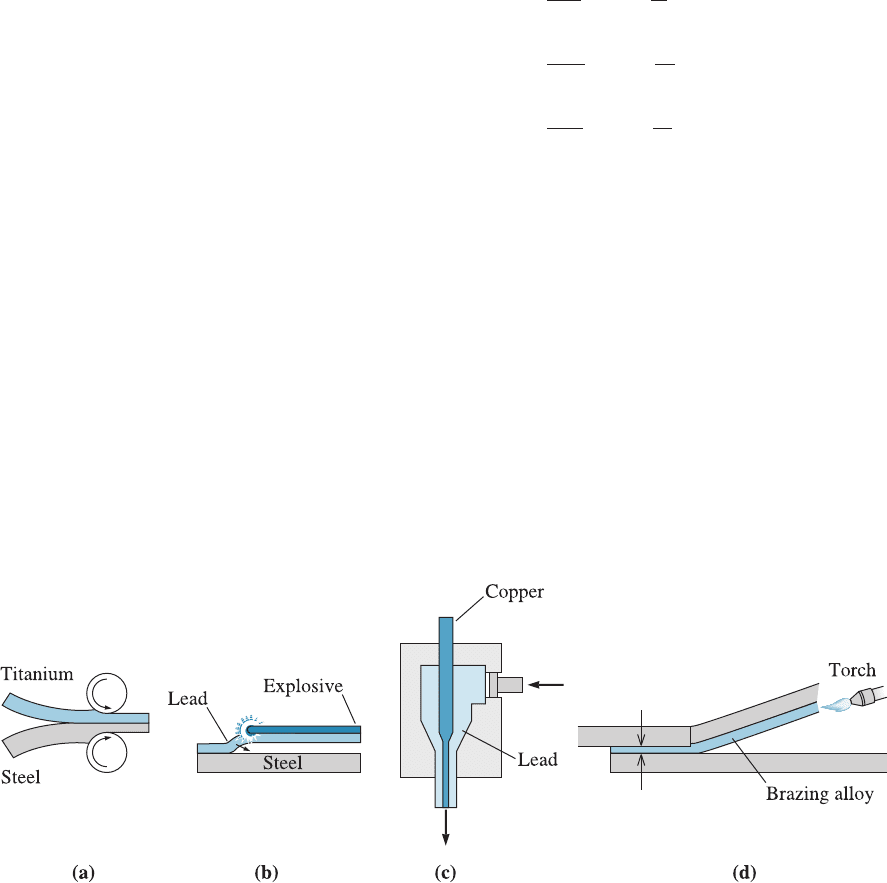
conductivity, and modulus of elasticity parallel to the lamellae can be calculated with
little error using following formulas:
Density ¼ r
c;k
¼
X
ðf
i
r
i
Þð17-13Þ
Electrical conductivity ¼ s
c;k
¼
X
ðf
i
s
i
Þ
Thermal conductivity ¼ K
c;k
¼
X
ðf
i
K
i
Þ
9
>
>
>
=
>
>
>
;
ð17-14Þ
Modulus of elasticity ¼ E
c;k
¼
X
ðf
i
E
i
Þ
The laminar composites are very anisotropic. The properties perpendicular to the
lamellae are:
Electrical conductivity ¼
1
s
c;L
¼
X
f
i
s
i
Thermal conductivity ¼
1
K
c;L
¼
X
f
i
K
i
9
>
>
>
>
>
>
>
>
>
=
>
>
>
>
>
>
>
>
>
;
ð17-15Þ
Modulus of elasticity ¼
1
E
c;L
¼
X
f
i
E
i
However, many of the really important properties, such as corrosion and wear resist-
ance, depend primarily on only one of the components of the composite, so the rule of
mixtures is not applicable.
Producing Laminar Composites Several methods are used to produce laminar com-
posites, including a variety of deformation and joining techniques used primarily for
metals. (Figure 17-30).
Individual plies are often joined by adhesive bonding, as is the case in producing
plywood. Polymer-matrix composites built up from several layers of fabric or tape pre-
pregs are also joined by adhesive bonding; a film of unpolymerized material is placed
between each layer of prepreg. When the layers are pressed at an elevated temperature,
polymerization is completed and the prepregged fibers are joined t o produce composites
that may be dozens of layers thick.
Most of the metallic laminar composites, such as claddings and bimetallics, are
produced by deformation bonding, such as hot- or cold-roll bonding. The pressure
exerted by the rolls breaks up the oxide film at the surface, brings the surfaces into
0.0075 cm
Figure 17-30 Techniques for producing laminar composites: (a) roll bonding, (b) explosive
bonding, (c) coextrusion, and (d) brazing.
C HA P T E R 1 7 Composites: Teamwork and Synergy in Materials576
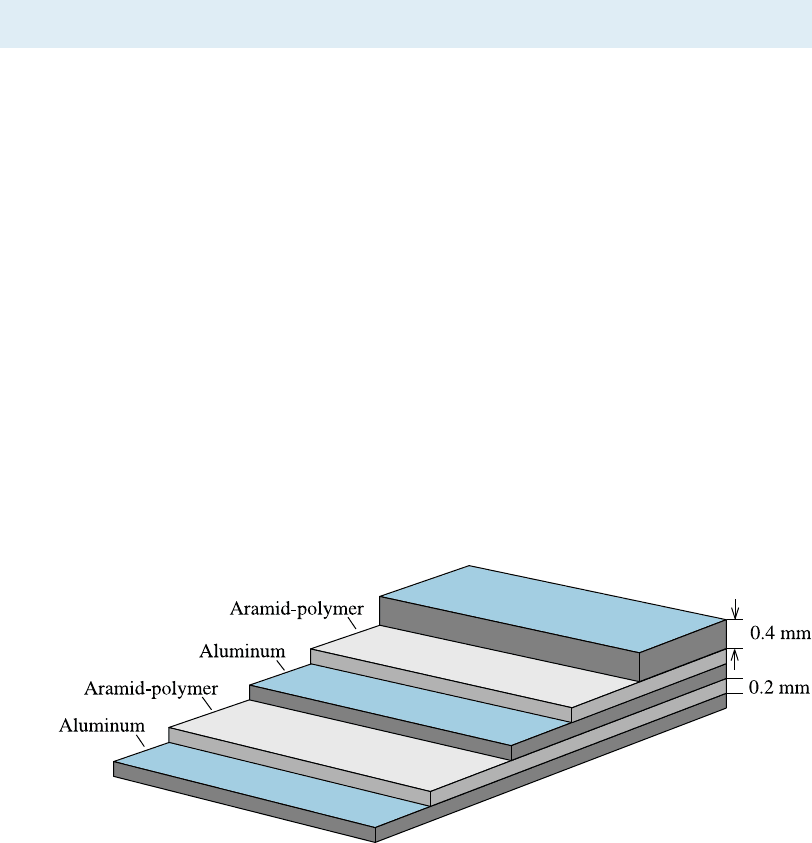
atom-to-atom contact, and permits the two surfaces to be joined. Explosive bonding
can also be used. An explosive charge provides the pressure required to join metals.
This process is particularly well suited for joining very large plates that will not fit into
a rolling mill. Very simple lami nar composites, such as coaxial cable, are produced by
coextruding two materials through a die in such a way that the soft material surrounds
the harder material. Metal conductor wire can be coated with an insulating thermo-
plastic polymer in this manner.
Brazing can join composite plates (Chapter 9). The metallic sheets are separated by
a very small clearance—preferably, about 0.0075 cm—and heated above the melting
temperature of the brazing alloy. The molten brazing alloy is drawn into the thin joint
by capillary action.
17-8 Examples and Applications of Laminar Composites
The number of laminar composites is so varied and their applications and intentions are
so numerous that we cannot make generalizations concerning their behavior. Inste ad
we will examine the characteristics of a few commonly used examples.
Laminates Laminates are layers of materials joined by an organic adhesive. In lami-
nated safety glass, a plastic adhesive, such as polyvinyl butyral (PVB), joins two pieces
of glass; the adhesive prevents fragments of glass from flying about when the glass is
broken (Chapter 15). Laminates are used for insulation in motors, for gears, for printed
circuit boards, and for decorative items such as Formica1 countertops and furniture.
Microlaminates include composites composed of alternating layers of aluminum
sheet and fiber-reinforced polymer. Arall (aramid-alumin um laminate) and Glare (glass-
aluminum laminate) have been developed as possible skin materials for aircraft. In
Arall, an aramid fiber such as Kevlar
TM
is prepared as a fabric or unidirectional tape,
impregnated with an adhesive, and laminated between layers of aluminum alloy (Figure
17-31). The composite laminate has an unusual combination of strength, sti¤ness, cor-
rosion resistance, and light weight. Fatigue resistance is improved, since the interface
between the layers may block cracks. Compared with polymer-matrix composites, the
microlaminates have good resistance to lightning-strike damage (which is important in
aerospace applications), are formable and machinable, and are easily repaired.
Figure 17-31 Schematic diagram of an aramid-aluminum laminate, Arall, which has potential
for aerospace applications.
17-8 Examples and Applications of Laminar Composites 577

Clad Metals Clad materials are metal-metal composites. A common example of clad-
ding is United States silv er coinage. A Cu-80% Ni alloy is bonded to both sides of a
Cu-20% Ni alloy. The ratio of thicknesses is about 1/6:2/3: 1/6. The high-nickel alloy is
a silver color, while the predominantly copper core provides low cost.
Clad materials provide a combination of good corrosion resistance with high
strength. Alclad is a clad composite in which commercially pure aluminum is bonded to
higher-strength aluminum alloys. The pure aluminum protects the higher-strength alloy
from corrosion. The thickness of the pure aluminum layer is about 1% to 15% of the
total thickness. Alclad is used in aircraft construction, heat exchangers, building con-
struction, and storage tanks, where combin ations of corrosion resistance, strength, and
light weight are desired.
Bimetallics Temperature indicators and controllers take advantage of the di¤erent
coe‰cients of thermal expansion of the two metals in laminar composite. If two pieces
of metal are heated, the metal with the higher coe‰cient of thermal expansion becomes
longer. If the two pieces of metal are rigidly bonded together, the di¤erence in their
coe‰cients causes the strip to bend and produce a curved surface. The amount of
movement depends on the temperature. By measuring the curvature or deflection of the
strip, we can determine the temperature. Likewise, if the free end of the strip activates
a relay, the strip can turn on or o¤ a furnace or air conditioner to regulate temper-
ature. Metals selected for bimetallics must have (a) very di¤erent coe‰cients of thermal
expansion, (b) expansion characteristics that are reversible and repeatable, and (c) a
high modulus of elasticity, so that the bimetallic device can do work. Often the low-
expansion strip is made from Invar, an iron-nickel alloy, whereas the high-expansion
strip may be brass, Monel, or pure nickel.
Bimetallics can act as circuit breakers as well as therm ostats; if a current passing
through the strip becomes too high, heating cau ses the bimetallic to deflect and break
the circuit.
Multilayer capacitors Similar geometry is used to make billions of multi-layer capaci-
tors. Their structure is comprisesd of thin sheets of BaTiO
3
-based ceramics separated by
Ag/Pd or Ni electrodes.
17-9 Sandwich Structures
Sandwich materials have thin layers of a facing material joined to a lightweight filler
material, such as a polymer foam. Neither the filler nor the facing material is strong or
rigid, but the composite possesses both properties. A familiar example is corrugated
cardboard. A corrugated core of paper is bonded on either side to flat, thick paper.
Neither the corrugated core nor the facing paper is rigid, but the combination is.
Another important example is the honeycomb structure used in aircraft applica-
tions. A honeycomb is produced by gluing thin aluminum strips at selected locations.
The honeycomb material is then expanded to produce a very low-density cellular panel
that, by itself, is unstable (Figure 17-32). When an aluminum facing sheet is adhesively
bonded to either side of the honeycomb, however, a very sti¤, rigid, strong, and excep-
tionally lightweight sandwich with a density as low as 0.04 g/cm
3
is obtained.
The honeycomb cells can have a variety of shapes, including hexagonal, square,
rectangular, and sinusoidal, and they can be made from aluminum, fiberglass, paper,
C HA P T E R 1 7 Composites: Teamwork and Synergy in Materials578
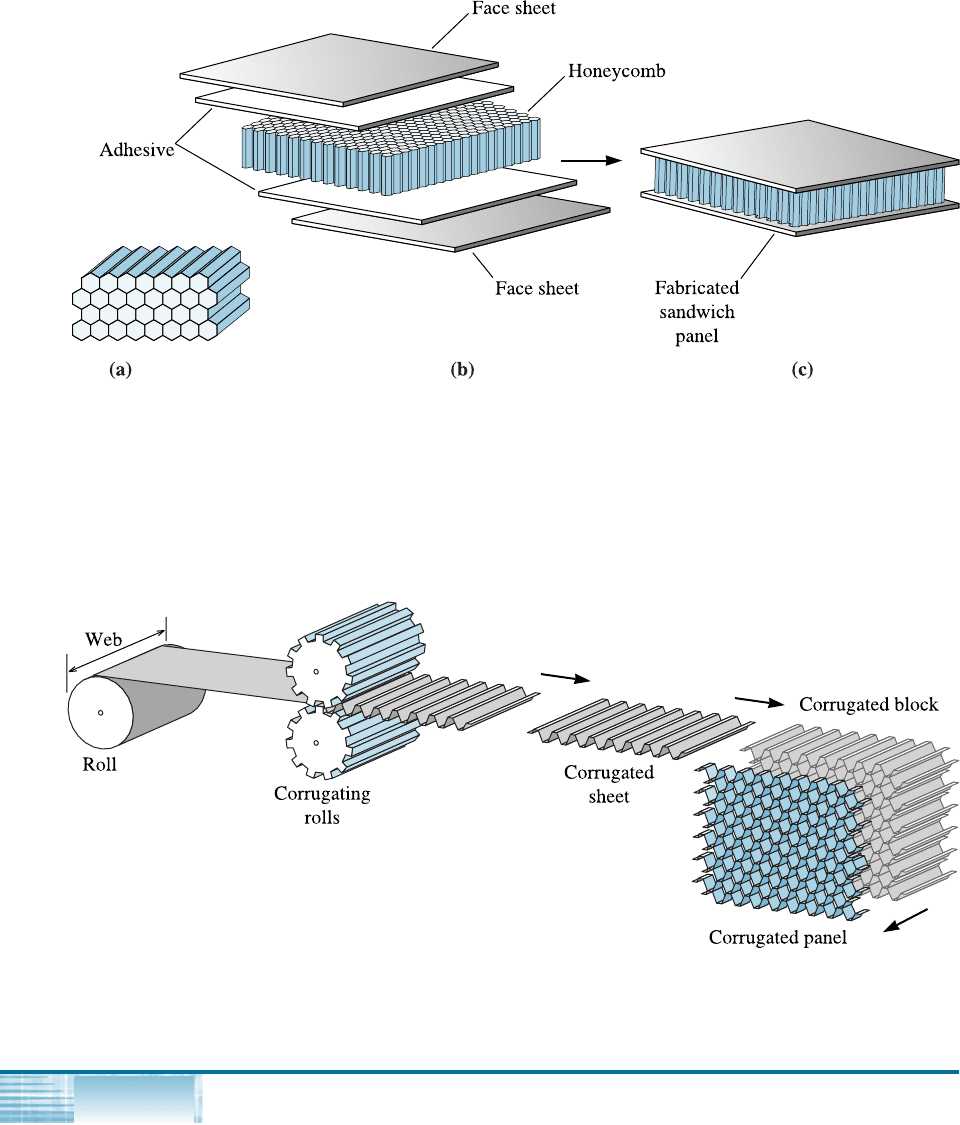
aramid polymers, and other materials. The honeycomb cells can be filled with foam or
fiberglass to provide excellent sound and vibration absorption. Figure 17-33 describes
one method by which the honeycomb can be fabricated.
SUMMARY
V Composites are composed of two or more materials or phases joined or connected
in such a way so as to give a combination of properties that cannot be attained
otherwise. The volume fraction and the connectivity of the phases or materials in a
composite and the nature of the interface between the dispersed phase and matrix
are very important in determining the properties.
Figure 17-32 (a) A hexagonal cell honeycomb core, (b) can be joined to two face sheets by
means of adhesive sheets, (c) producing an exceptionally lightweight yet stiff, strong
honeycomb sandwich structure.
Figure 17-33 In the corrugation method for producing a honeycomb core, the material (such
as aluminum) is corrugated between two rolls. The corrugated sheets are joined together with
adhesive and then cut to the desired thickness.
Summary 579
